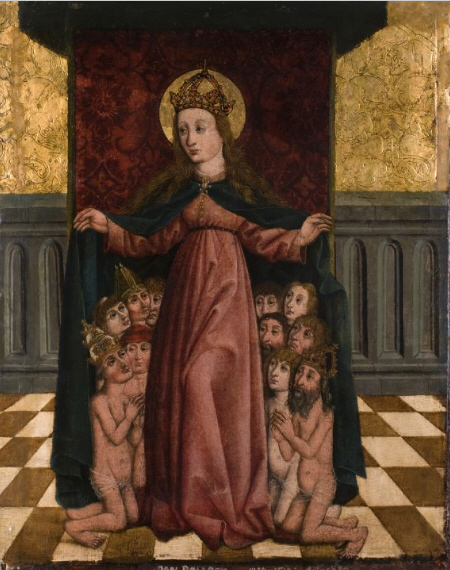
Our Lady of Mercy

Our Lady of Mercy is a subject in Christian Art, showing a group of people sheltering for protection under the outspread cloak, or pallium of the Virgin Mary. It was especially popular in Italy from the 13th to 16th centuries, often as a specialised form of votive portrait, and is also found in other countries and later art, especially Catalonia and Latin America. In Italian it is known as the Madonna della Misericordia (Madonna of Mercy), in German as the Schutzmantelmadonna (Sheltering-cloak Madonna), in Spanish Virgen de la Merced or Nuestra Señora de las Mercedes (Our Lady of Mercy), in French as the Vièrge au Manteau or Vierge de Miséricorde (Virgin with a cloak or Virgin of Mercy) and in Catalan as the Mare de Déu de la Mercè.
Usually the Virgin is standing alone, though if angels hold up the cloak, she is free to hold the infant Christ. The people sheltered normally kneel, and are of necessity shown usually at a much smaller scale. These may represent all members of Christian society, with royal crowns, mitres and a papal tiara in the front rows, or represent the local population. The subject was often commissioned by specific groups such as families, confraternities, guilds or convents or abbeys, and then the figures represent these specific groups, as shown by their dress, or by the 15th century individual portraits. Sometimes arrows rain down from above, which the cloak prevents from reaching the people.
Probably the oldest version known is a small panel by Duccio of c. 1280, with three Franciscan friars under the cloak, in the Pinacoteca in Siena. Here the Virgin sits, only one side of the cloak is extended, and the Virgin holds her child on her knee with her other hand. An miniature of c. 1274 from the Armenian Kingdom of Cilicia also shows a variant of the motif, as do 13th century paintings in Cyprus, such as an icon in the Byzantine Museum in the Archbishop’s Palace, Nicosia. The common factor between all these is the influence and presence of Western mendicant orders, especially the Franciscans, who appear to have been important in spreading this form of iconography.
The immediate inspiration of the iconography comes from a vision reported in the Dialogus Miraculorum of the Cistercian Caesarius of Heisterbach which circulated widely from about 1230. Beyond that, the origins of the image may relate to rituals and a vision or miracle connected with a famous icon in the Blachernae Church in Constantinople. This gave rise in the Byzantine Rite (Eastern Orthodox and Eastern Catholic Churches) to the Pokrov icons, although the image is not found in Byzantine art. In the Pokrov icons the thought is similar, but the image is usually less literal — the veil with which the Virgin protects mankind is small and held either in her hands or by two angels, though the Western version with a larger cloak is found in some Eastern Orthodox icons, one of a number of Western iconographic features that infiltrated Orthodox art, whether in Cyprus under the Crusaders or 16th-century Eastern Europe.
Usually the image, whether in sculpture or painting, stands by itself, but in the most famous example, the Madonna della Misericordia altarpiece in Sansepolcro by Piero della Francesca, of 1445-62, the subject is the central panel of a large altarpiece, with a smaller Crucifixion above it, and many other panels. In the Spanish The Virgin of the Navigators of the 1530s, where those sheltered are a group connected with the Spanish voyages to the New World, including American indigenous peoples, the group is shown over a panorama of ships at rest in a harbour.
The liturgical feast day of Our Lady of Mercy is celebrated annually in the Latin Catholic calendar on September 24.
Churches dedicated to her include the cathedral of Guasdualito in Venezuela.
The term “our Lady of Mercy” is found in a number of other contexts not directly related to the image. It is a common translation of the Eleusa type of icon of the Virgin and Child. The Virgin of Mercy is patron saint of Barcelona, celebrated in the week-long La Mercè festival each year, but in this role is not especially associated with this type of image. The Order of the Blessed Virgin Mary of Mercy, founded, also in Barcelona, in 1218 by Saint Peter Nolasco, has used the image but is not particularly associated with it.